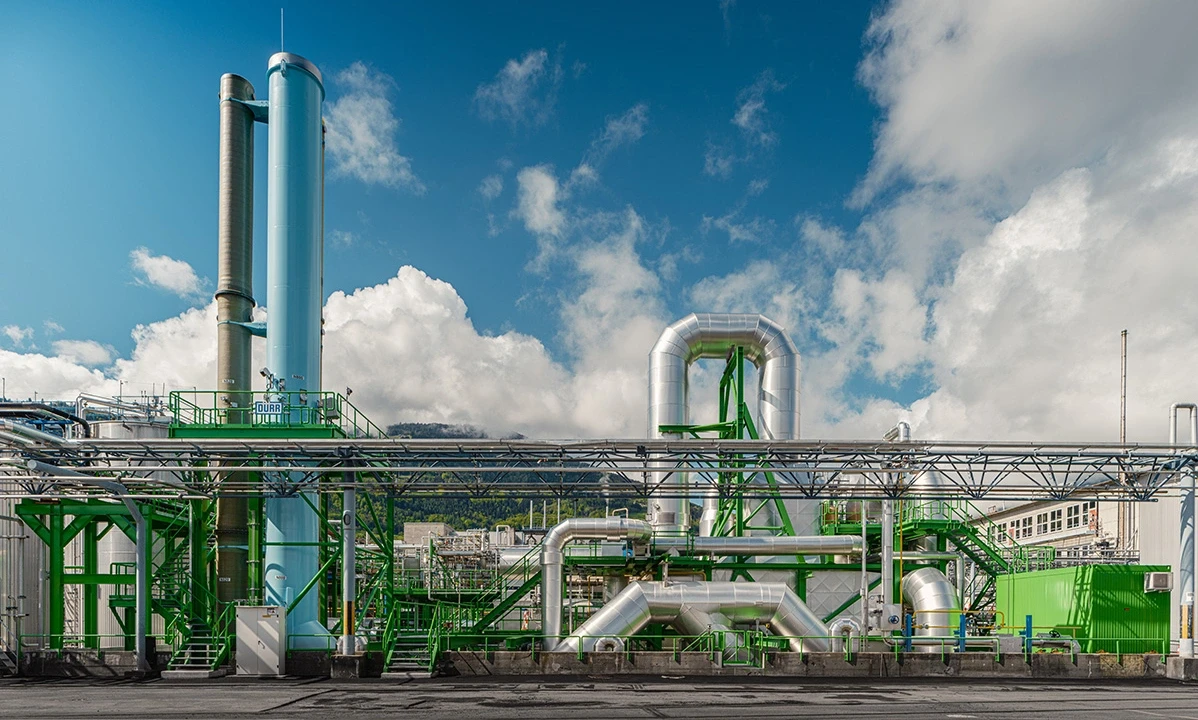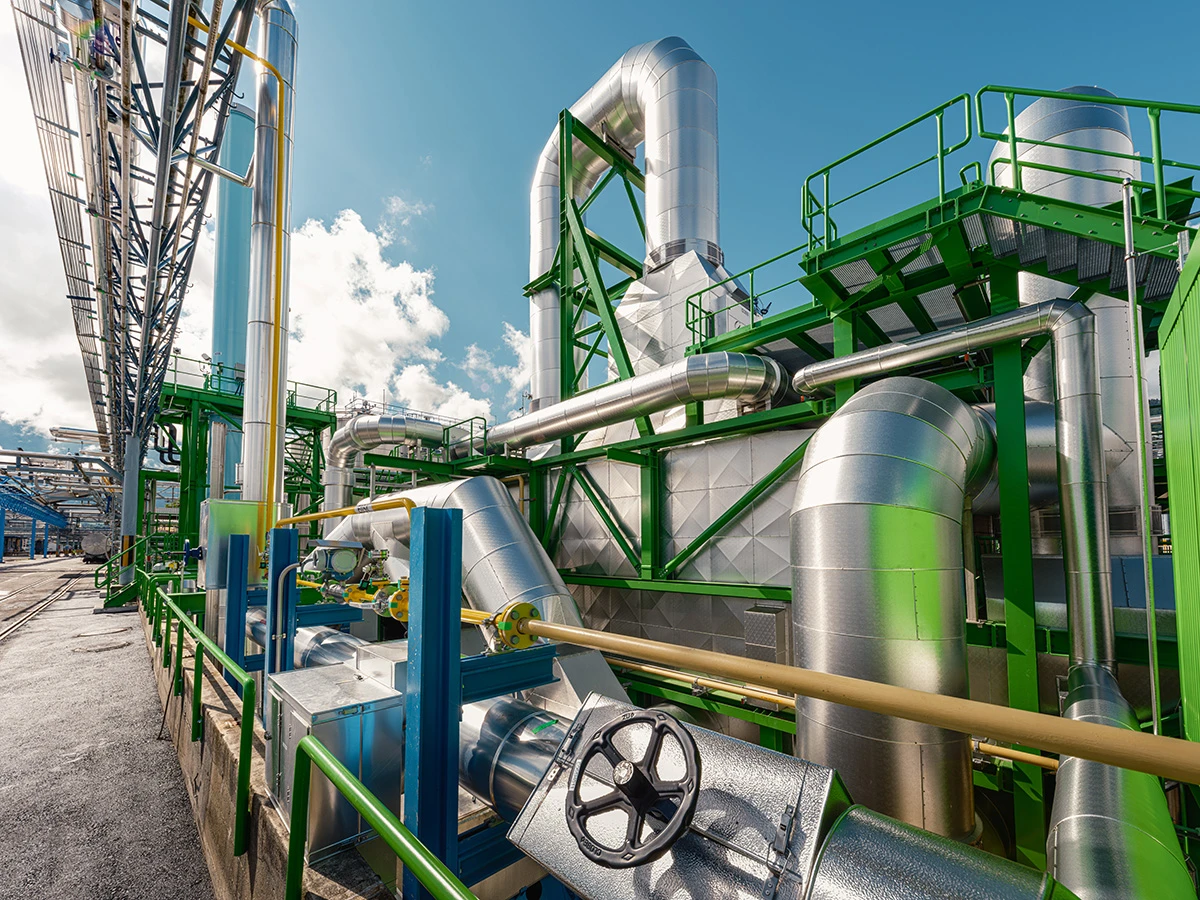
One for all
May 3, 2024
An innovative air pollution control system purifies highly complex exhaust gases with almost no fossil fuel use
Syngenta, a top producer of seeds and crop protection products, planned to replace three decentralized air pollution control systems at its site in Monthey, Switzerland. To find the best solution, the company launched an engineering competition. Dürr emerged as the winner with its unique centralized system concept, which minimizes fossil fuel usage and aligns with Syngenta’s ambitious carbon reduction goal.
The company asked itself one essential question at the beginning of the project: Would a single central exhaust air purification system better suit our needs than three decentralized ones? Magnus Morsch, Dürr Global Customer Director of Sales in the environmental technology field, sees this as a philosophical question because both approaches have their merits. “From a technical point of view, it’s just easier to adapt your current system to a specific process. Regarding construction costs, operation, servicing, and energy use, centralized systems can, however, be the better choice – provided they offer the flexibility to process a wide range of materials."
Carbon footprint as a fixed parameter
Project teams from various providers developed concepts as part of the engineering competition. The company weighed the pros and cons of various processes and their combinations using specialized calculation models. In the end, Syngenta opted for Dürr’s innovative concept, featuring a centralized air pollution control system based on regenerative thermal oxidation (RTO). Dürr won the competition because of an extremely sophisticated process concept, built modularly around the core ─ the Oxi.X RE RTO. Syngenta’s priority was to minimize fossil fuel usage to further reduce carbon emissions and energy consumption at the Monthey site. “With our commitment to responsible growth, we aim to halve the carbon intensity of our global activities by 2030,” says Matteo Scalabrino, Project Manager at Syngenta. “Therefore, we must be proactive in continuous process improvements, including air pollution control.”

One that must be able to do it all
The plan was to build the new centralized air pollution control system on a decommissioned tank farm site. This posed a challenging task for Dürr: size the system to fit on a small, 35 x 35-meter area while allowing space for planned expansion stages. However, the far bigger challenge was combining existing and newly developed technologies intelligently to meet Syngenta’s requirement to process all exhaust air flows through a single system.
What is meant by highly complex exhaust gases?
Gaseous residues from chemical production typically contain high concentrations of organic ingredients, making them high-calorie gases. This not only applies to oxidation itself but also the downstream processes like flue gas scrubbing and heat recovery ─ especially when several different substances require simultaneous treatment. “Therefore, we have to deal with a variety of substances that vary greatly in both their operational states and potentially in their quantity,” says Magnus Morsch.
Intelligent product combination, smart process management
Pipelines spanning several kilometers long transport exhaust air from 70 individual sources to the new air pollution control system, where the connections bring the individual building exhaust gases together in one mixing chamber. Here, several substances can react with each other, which is why Dürr designed this self-cleaning chamber specifically for Syngenta, so that any crystal formations, for example, are automatically removed.
If the exhaust air flows contain a high percentage of organic compounds, this will compensate for the RTO energy losses that, normally, would have to be balanced by a gas burner. A large amount of hot gas must be diverted to keep the RTO system balanced from an energy standpoint. Dürr directs this surplus energy into the separate reaction chamber mounted on the RTO.
If the concentration of pollutants in the exhaust air is high enough, we can cover the energy requirement for the oxidation of the exhaust air stream containing CS2 with the excess heat from the RTO system. The process, which we developed here, is practically self-sustaining in terms of energy.
Magnus Morsch, Global Customer Director Sales, Clean Technology Systems, Dürr Systems AG
The exhaust air scrubber (Sorpt.X SW) is the next treatment stage after the RTO system. This wet scrubber,equipped with random column packing, transfers the acidic components left after oxidation from the gas phase to the liquid phase. The plant’s wastewater treatment facility disposes of the liquid waste. The condensate is used as scrubber fluid to minimize operating and investment costs associated with steam condensate disposal.
Once the organic compounds are incinerated and other pollutants are scrubbed from the exhaust air, only nitrogen components remain. In the final step, Dürr’s system facilitates the selective catalytic reduction of NOx, converting the nitrogen oxides present in the flue gas. At the end of the purification process – after another thorough measurement – the stack releases completely purified air into the atmosphere.

Fertile ground, also for innovation
The two coupled thermal systems require little to no burner operation, because of their intelligent use of energy from pollutants. As a result, there are little to no fossil fuels to feed the burners and bring the reaction chambers to temperature. This is a strategic advantage for Syngenta and its ambitious plans to reduce carbon emissions and energy consumption. “Natural gas was the typical fuel source for the old incineration plants in Monthey. By gradually decommissioning them and replacing them with Dürr’s energy-efficient solution, we’ve already permanently reduced our need for fossil fuels, positively affecting our carbon footprint,” says Matteo Scalabrino, Project Manager at Syngenta.
The Dürr team is pleased that its innovative concept was so well received by Syngenta. The construction of this type of air pollution control system is unique to date. This “self-sufficient” energy supply is a patented invention.



